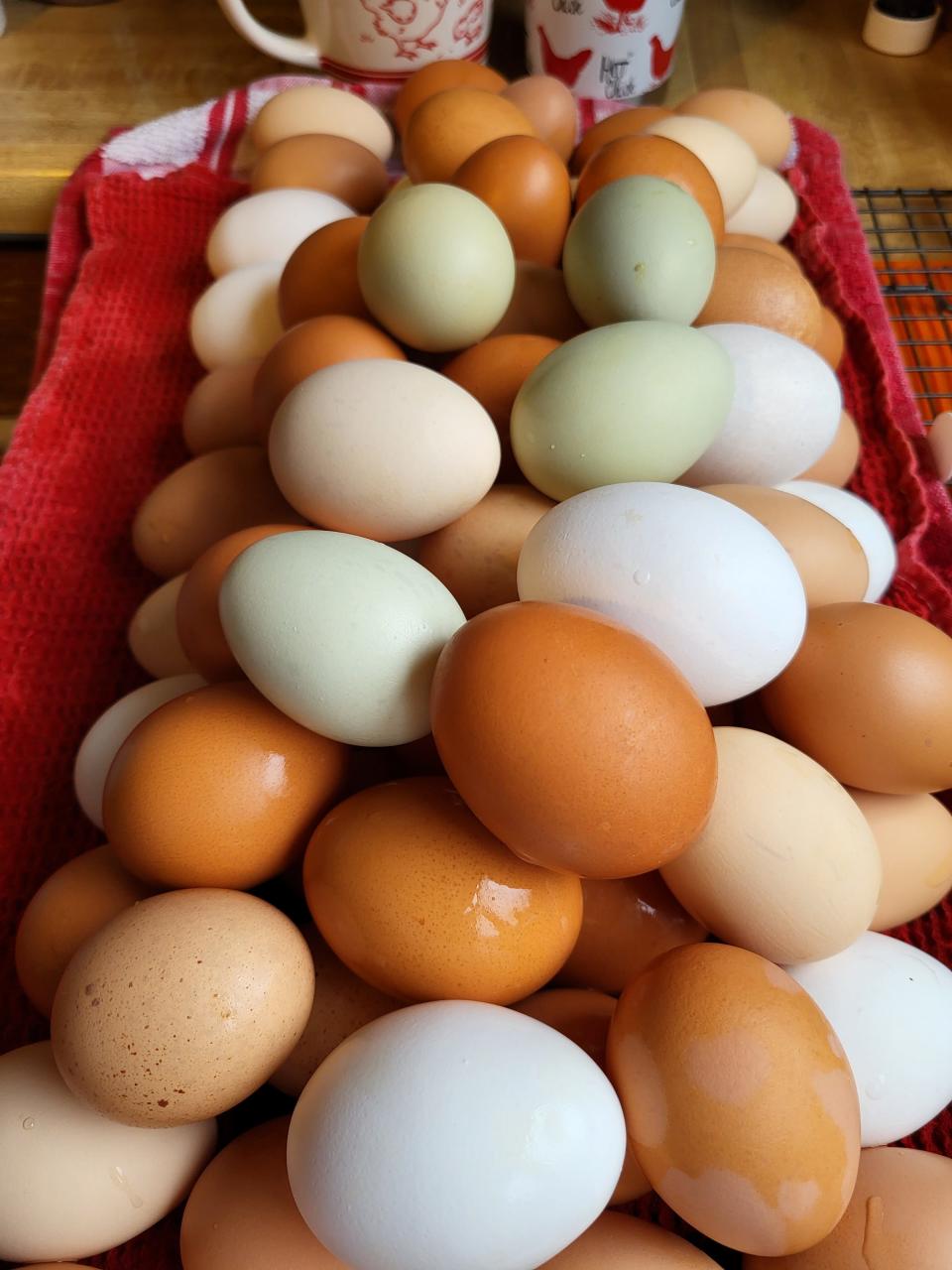Don't adjust your eyes. These 'Easter Egger' chickens lay colored eggs
BETHLEHEM TWP. − Who needs the Easter Bunny when you can raise chickens that lay colored eggs?
On their five acres of paradise, Jason and Stephanie Haines and their six children raise nearly 150 chickens, including "Easter Egger" hens which produce colored eggs that resemble Easter eggs.
"Easter sees a great demand," Stephanie Haines said.
Some people breed chickens to lay certain colored eggs. The most common colors are light blue, light green, olive, brown, red, copper, cream, pale pink, and speckled.
Easter guide:Your guide to Easter-themed activities in the Canton area
When is Easter 2023:How the holiday's date each year is determined and why some celebrate.
Haines said that in addition to their colorful shells, colored eggs contain more nutrients than white ones, and noted that because of the shortage in stores due to an outbreak of avian flu affecting commercial breeders, demand has been so high for her eggs, she's had to freeze her customer list.
"Farm fresh eggs test much better than store-bought eggs," she said. "Also, this year has been different because of the cost of eggs. I charge less than the stores. Everybody wants eggs."

'People call me The Crazy Chicken Lady.'
A member of the Stark County Poultry Committee, Haines loves to talk about the art of raising chickens, of which there are more than 500 breeds.
"People call me 'The Crazy Chicken Lady,'" she said, laughing. "There's a lot to know about chickens."
Haines said one easy way to tell what color eggs a hen lays is to examine the color of her earlobes.
You read that right. Chickens have ears.
All of the Haines' school-age children raise chickens and are members of 4-H. Their children are Bryce Hughes, 16, Knox Hughes, 14, Chance Haines, 12, Gracie Haines, 9, Preston Haines, 3, and Hudson Haines, 11 months.
4-H still popular:Stark County Fair - a junior fair this year - ends with many awards

Stephanie Haines, who grew up on a farm in Kensington, said she began raising chickens as a hobby after quitting her job to care for one of their sons, who has special needs.
The family also raises turkeys and quail.
How do Easter Egger hens produce colored eggs?
Heather A. Neikirk, an educator of agriculture and natural resources at the Ohio State University Extension Stark County, said a number of breeds produce colored eggs, including Araucana, Ameraucana, Cream Legbar, Easter Egger, Rhode Island Red, Orphington, Plymouth Barred Rock, Sussex, Marans, Welsummer, Silkies, and Mottled Javas.
Easter Egger hens, she said, are a cross of the South American Araucana breed that traditionally lays blue eggs, with another breed.
"The color of egg produced by these hens can range from light blue, green to pink in color based on the breed that they are crossed with," she said. "Ameraucana chickens possess the pigment, oocyanin (blue coloring). It permeates the shell and results in the egg being both blue on both the inside and outside."
Egg colors, Neikirk said, are determined by a hen's genetics. For instance, an "Olive Egger," a chicken that lays olive-green colored eggs, is a cross between a hen and rooster from a brown egg layer and a blue egg layer breed.

The colors are produced by pigments that are deposited as the egg travels through the oviduct.
Egg prices scramble budgets:Eggs-actly what's the deal with those high egg prices?
"Certain breeds of chickens contain certain pigments," she explained. "All eggs begin with a white outer shell, and as the egg moves through the oviduct genetic pigments are deposited on the shell at varying points in the egg development process thus producing various colors on both the inside and outside of the egg."
For example, brown-egg chickens possess the pigment protoporphyrin (brown coloring), Neikirk said.
"This pigment is added late in the formation process and only tints the surface of the egg," she said. "That is why brown eggs have brown outer shells with white inner shells. The Olive Egger has the brown pigment that then overlays the blue egg shell which results in the olive-green coloring of the egg. The darker the brown pigment, the more olive in color the egg."
Neikirk said no breeds lay "true" purple or lilac-colored eggs.
Reach Charita at 330-580-8313 or charita.goshay@cantonrep.com.

On Twitter: @cgoshayREP
Five things to know about Easter eggs:
One ancient church tradition is that the Easter egg represents the resurrection of Christ. Cracking the shell symbolizes the opening of Jesus' tomb; the egg white represents his burial shroud; the yolk represents new life.
Because of their fertility, particularly in the spring, rabbits became a popular symbol of Easter. According to Good Housekeeping, the Easter Bunny was introduced by German immigrants in Pennsylvania in the 1700s, based on an egg-laying rabbit known as “Osterhase” or “Oschter Haws," who delivered eggs to good children. In anticipation, children made nests for Osterhase, which eventually became the Easter basket.
According to Guinness World Records, the largest Easter egg hunt ever took place in 2016 at the Cypress Gardens Adventure Park in Winter Haven, Florida. More than 9,700 children and parents searched for 501,000 Easter eggs.
Decorating eggs predates Christianity, in celebration of spring. Ukrainian Christians are credited with adopting decorated eggs as an Easter tradition, starting in the 10th century.
An estimated 180 million eggs are dyed during the Easter season.
This article originally appeared on The Repository: No dye needed. Easter Egger chickens produce colored eggs

